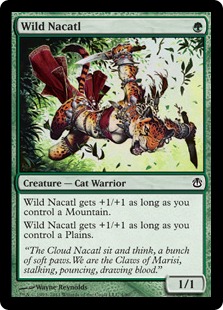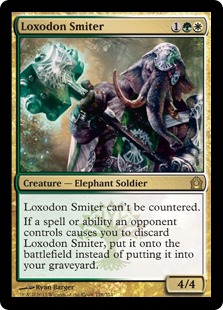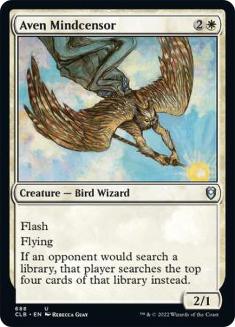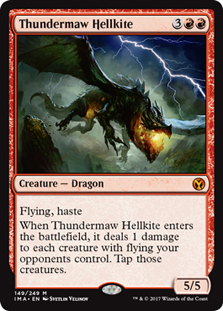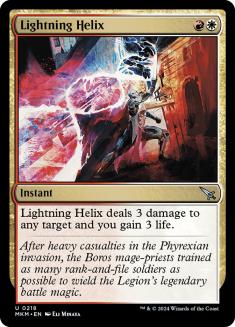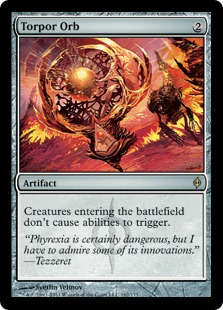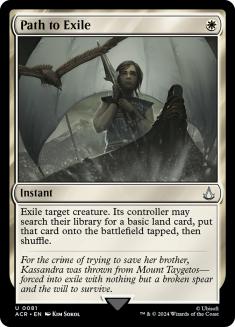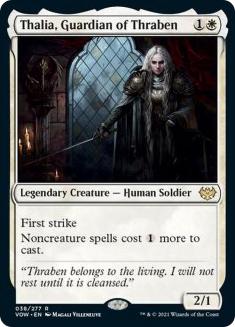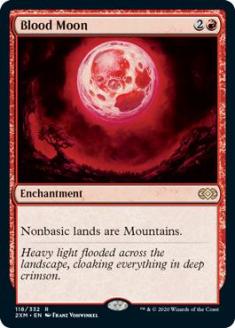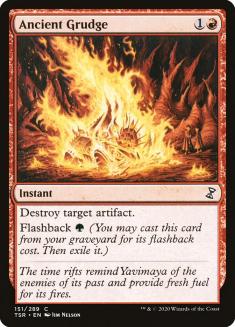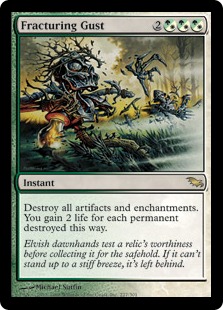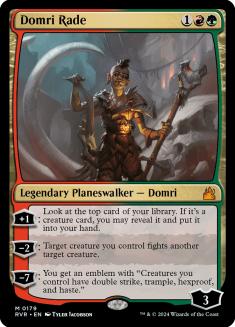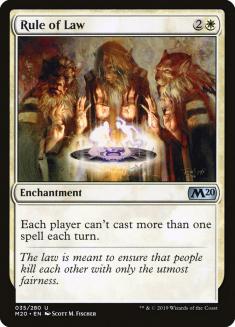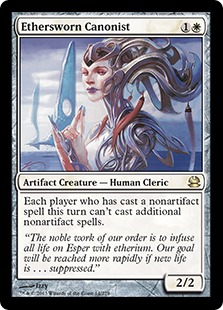Modern is an incredibly diverse format. At Pro Tour Born of the Gods in Valencia, Spain, only two decks made up more than ten percent of the metagame, and one of those—Zoo—was really a number of different decks lumped together under one umbrella. And that was an event with just a few hundred players! At a tournament like this weekend’s record-breaking Grand Prix Richmond, we can be sure to see even more variety.
When an event gets as big as Richmond, it isn’t simply because a few more regular PTQ players decided to make the trip. Tournaments reach this magnitude by drawing on a different audience entirely, which means you’re not going to see the same kind of metagame you might expect elsewhere. If you thought the field at the Pro Tour was diverse, just wait until the 4,000+ competitors in Richmond bust out their home brews and pet decks.
This makes it more important than ever to play a deck that is fundamentally powerful and proactive. I always advocate for this kind of thing, but it’s especially important to be the one asking the questions in a huge field when you have little chance of predicting everything you might be expected to answer. Do you really want to show up to a 4000+-player tournament with a "metagame deck" you designed to combat decks that only make up a small fraction of the field?
Additionally, such a huge and diverse tournament should influence not only your deck choice but your specific card selections as well, especially when it comes to your sideboard. The bigger and less predictable the tournament field is, the more important it is to play cards that are not only powerful but broadly impactful and relevant in a wide variety of matchups.
For instance, at Pro Tour Born of the Gods, I played Fulminator Mage and Tectonic Edge in the sideboard of my Naya deck because I anticipated U/W/R Control and Scapeshift to be significant players in the format and felt like those cards offered me the most value in those particular matchups. For Richmond, however, I feel quite strongly that a more broadly impactful and more objectively powerful card like Blood Moon is the better choice. Not only is Blood Moon still a good card in the matchups where I already wanted it, but it’s also a potential hoser against a huge variety of other possible decks in the format, whether I have anticipated playing against them or not.
No matter what deck you choose to play this weekend in Richmond, keep these basic principles in mind: be powerful, be proactive, and be flexible.
I really shouldn’t be going to Richmond. I’m going to be in Austin, Texas on Friday night before the tournament to speak on a panel at the SXSW Gaming Expo (if you’re in the area, it’s on the Geek Stage at 6:30 PM, and it’s free and open to the public, so come on by). I’m flying to Richmond on the only flight I could find on Saturday morning that could get me to the site by the time my byes should be over. I booked a ticket late last week because I was just fiending to play more Modern because I really enjoyed preparing for and playing the format at the Pro Tour. I liked my deck and thought it was very good and have continued to have success with it in practicing since. But more importantly, I’m a crazy person who craves competition, and nothing makes me thirsty to prove that I can win more than losing.
Here is the deck that I have sleeved and ready to take with me on my crazy trip:
Creatures (26)
- 1 Birds of Paradise
- 4 Tarmogoyf
- 4 Wild Nacatl
- 4 Noble Hierarch
- 4 Knight of the Reliquary
- 2 Qasali Pridemage
- 3 Scavenging Ooze
- 2 Thundermaw Hellkite
- 2 Loxodon Smiter
Planeswalkers (2)
Lands (19)
Spells (13)

When I first built the Naya deck that I played to a Top 8 finish at Grand Prix San Diego last year, it was a metagame deck. I built it to prey upon the U/W/R Control and Jund decks that were so popular at the time. It did so admirably thanks to its ability to out-midrange those decks with creatures that are tough to handle like Loxodon Smiter and Knight of the Reliquary and planeswalkers, specifically Domri Rade.
I would not play that deck in Richmond. It was too tailored to competing in that particular field. While the deck certainly had powerful elements and was definitely proactive, its effectiveness relied heavily on the contextual power of its specific threats.
So why am I not only advocating for this deck now but also planning on playing it myself? Simple:
Let me turn back the clock a few years to 2009. In our testing for Pro Tour Austin, we knew that Zoo was going to be the most popular deck in the field. I didn’t like how most Zoo decks played out, especially in a world where it was highly anticipated. They’d play out a bunch of one-drops and get some damage in and then get brick walled by a Tarmogoyf or a Kitchen Finks and have to just hope to draw enough burn to win.
I kept building creature decks like Bant, intending to go over the top of Zoo with stuff like Rhox War Monk and Baneslayer Angel, but none of them seemed to really have what it took to compete with the field at large even if they could beat Zoo handily—and not all of them could even do that. No matter how many bigger creatures you might be able to muster, sometimes your opponent just had a draw with a couple of Wild Nacatl and a Path to Exile and would blow right by you.
This begged the question why we were not just playing Wild Nacatl ourselves. It was really strange how novel an idea that seemed to be at the time. Ben Rubin and I took all of the various midrange tools that we wanted against Zoo and the rest of the field—Knight of the Reliquary, Punishing Fire plus Grove of the Burnwillows, and even Baneslayer Angel—and merged them with the true core of the Zoo shell made up of Wild Nacatl, Tarmogoyf, and Lightning Bolt. Suddenly we had a deck that was capable of presenting a fast clock but still had a tremendous amount of staying power.
And the rest, as they say, was history.
The point of that trip down memory lane—other than to shamelessly reference my first Pro Tour win of course—is that Wild Nacatl adds a completely different element to a deck like this one. Take out Nacatl and this deck—like my Naya deck from the last Modern season or the other decks I was testing for PT Austin—is decidedly midrange and incapable of presenting a particularly fast clock. While such a deck may be well suited to a particular environment, it isn’t what I would want to play in a wide-open field in a fast format like Modern. But with Nacatl in the deck, you can get draws that are able to kill incredibly quickly, which both forces opponents to play and sideboard against you differently and gives you a much better chance to win games before your opponent can implement their own game plan.
So do you want to attack with Wild Nacatl yet? Yes? Well good. You have excellent taste. Now let’s talk about how best to do it. While we certainly can’t plan for everything we may run into in Richmond, we might as well prepare for what we can. Let’s talk about how things go against some of the more popular decks out there.
Zoo
Zoo was the most popular deck in Valencia, and while it did not perform especially well there, it will certainly still show up in Richmond. I played against Zoo three times at the Pro Tour, and I won all three matches. All of my opponents were playing more aggressive builds featuring cards like Kird Ape, Loam Lion, and either Experiment One and Mutagenic Growth or Tribal Flames and Snapcaster Mage. The way you approach these matchups is similar, though very much tailored to the particular cards your suspect your opponent is playing.
There are some key things to keep in mind. If you’re going to use a Lightning Bolt or Lightning Helix, do it on your own turn—don’t get clever and wait until your opponent attacks because you can get blown out by Ghor-Clan Rampager or Mutagenic Growth. The opposite is true with Path to Exile—when possible, try to save them until the last possible moment to beat your opponent’s combat tricks.
Be careful with your life total. You are the control deck here, and your opponent is trying to close the window for your more powerful cards like Knight of the Reliquary to get online by burning you out. Fetch basics when you can and don’t pay life to "thin your deck." I won a game in the Pro Tour with multiple uncracked fetch lands in play, even letting my opponent kill my blocking Knight with a Mutagenic Growth to avoid falling into Lightning Bolt range.
When possible, avoid playing Tarmogoyf or Scavenging Ooze that can just die to an opposing Lightning Bolt. It’s fine to play out an Ooze to die if it means you’ll get to play a 3/4 Goyf, but generally you want to try to give your opponent as little value for their burn spells as possible.
Sideboarding
No changes.
Birthing Pod
A lot of the strength of Big Zoo compared to aggressive Zoo decks is that it matches up much better against decks like Birthing Pod. It’s difficult for Pod to combo kill you because you have so much removal, so they have to try to play a long grindy game against you. Against typical Zoo decks, they’re usually very much advantaged thanks to cards like Kitchen Finks. Your deck actually has a very strong long game as well however. You can easily overpower their creature plan thanks to Knight of the Reliquary and Kessig Wolf Run along with Scavenging Ooze to disrupt their persist shenanigans and Qasali Pridemage to kill Birthing Pod itself.
Your most important card in this matchup is Knight of the Reliquary. If you have to decide between playing Noble Hierarch to play a turn 2 Knight or a Wild Nacatl on the first turn, you want to ramp out the Knight—their deck is much better suited to handle small creatures than big ones, and you want to be able to search up Kessig Wolf Run to break through their blockers.
Use your judgment about when to use your removal on your opponent’s mana creatures and when to hold on to it. The more aggressive your draw is, the more valuable it is to kill Birds of Paradise and Noble Hierarch. Remember that most Pod decks have very few copies of their actual combo pieces, so you’re usually better off focusing on using your removal to get damage in and restrict your opponent’s options than to save it to try to protect yourself from their combo.
Sideboarding
Out:
In:
I don’t particularly like Torpor Orb in this matchup because they have access to Abrupt Decay anyway, and while it can mitigate some of the effectiveness of cards like Kitchen Finks, Murderous Redcap, and Shriekmaw, it doesn’t stop them from comboing off with Archangel of Thune + Spike Feeder or just burying you with value from Reveillark and Voice of Resurgence.
Splinter Twin
Twin is one of the matchups in which Wild Nacatl makes a big difference. When my deck was more of a Loxodon Smiter deck, it was difficult to deploy enough to the board early to avoid having to tap out and just leave myself vulnerable to a Twin combo. With Nacatl, however, you can put your opponent on the back foot early and keep up mana for removal.
When you’re playing the Twin dance—that is, trying to play around your opponent playing an end step Pestermite or Deceiver Exarch and tapping one of your lands and then untapping and playing Splinter Twin on it—be sure to keep up fetch lands. If you use all of your fetch lands, your opponent can frequently find an opening when you have only a single land untapped, tap it down, and then combo off on their following turn. If you constantly leave up a land that you can use to fetch white mana, you can always crack it in response if they try to tap it down so you can at least threaten Path to Exile.
Sideboarding
Out:
In:
Your sideboard plan varies a bit based on your opponent’s build of the deck. If your opponent is a heavier combo version with four Pestermite and Kiki-Jiki, Mirror Breaker, you want to keep Lightning Helix and take out a Domri Rode. Your general plan after sideboarding remains the same, but now you have access to Choke to potentially attack your opponent’s mana. Be careful to fetch basics to play around potential Blood Moon, and don’t deploy too many creatures to the board that can be swept up by Anger of the Gods.
U/W/R Control
There are lots of varieties of U/W/R Control, but I expect most of them moving forward will be similar to Shaun McLaren’s winning list. That’s good for you because controlling U/W/R decks are exactly what this kind of deck was built to beat. Your best card in game 1 by miles is Domri Rade. U/W/R Control decks are poorly set up to beat planeswalkers in general, and Domri can generate tremendous card advantage as he builds toward a nearly unbeatable ultimate. Your worst cards are definitely your removal spells. You’re not quite aggressive enough to win by burning your opponent out, especially through Lightning Helix and Snapcaster Mage, so they mostly rot as low-impact cards in your hand the whole game.
Playing against U/W/R Control is mostly about trying to get the most out of the resources you have. Knight of the Reliquary, Loxodon Smiter, and Thundermaw Hellkite are your best creatures here because they survive Lightning Bolt. Kessig Wolf Run is key to making all of your creatures threats, so if you get an active Knight for a turn, be sure to fetch it rather than just hit for some non-lethal damage to make your future Noble Hierarch and the like into real threats.
Sideboarding
Out:
In:
After sideboarding you have six separate three-mana noncreature permanents that have the potential to dominate the game. Choke and Blood Moon join Domri Rade as difficult to remove cards that give your opponent fits. Sideboarded games are typically much better than game 1 because you’re able to upgrade quite a few virtual dead cards into great ones.
Affinity
Affinity had a decent showing at the Pro Tour, and it’s the kind of deck some people just love. Game 1 isn’t great because you only have so many cards that can actually interact with their important permanents like Cranial Plating. You need to play aggressively to close out the game because a Plating or Etched Champion can often turn the game around almost instantly. Use Knight of the Reliquary to find Kessig Wolf Run to force damage past a Champion that your opponent leaves on defense.
Sideboarding
Out:
In:
You’re in much better shape after sideboarding. Ancient Grudge gives you a lot of breathing room to keep you from dying to a quick Arcbound Ravager or Cranial Plating, and Fracturing Gust is a stone-cold killer.
Storm
Storm isn’t the deck you’re playing Big Zoo to beat, but it’s winnable. You’re really looking for an aggressive start in game 1 with Wild Nacatl and potentially Scavenging Ooze or Qasali Pridemage for some disruption.
Sideboarding
Out:
In:
After sideboarding you’re in much better shape. You have six cards that dramatically disrupt your opponent’s ability to go off in addition to the naturally disruptive creatures in your maindeck. You’ll want to mulligan aggressively to one of your sideboard cards because it’s very difficult for you to win with a normal creature draw even if it’s extremely fast.
Burn
This is a tough matchup, but it’s not unwinnable. Be extremely careful with your fetch lands and avoid taking damage whenever possible. Their deck is looking to assemble twenty damage, and even a single extra point you deal to yourself can mean an entire extra virtual card for them. Scavenging Ooze and Lightning Helix are your most important cards here.
Sideboarding
Out:
In:
These sideboard cards may seem out of place here, but Burn relies heavily on its ability to string together multiple cheap spells in a single turn to end the game. Both Thalia, Guardian of Thraben and Ethersworn Canonist are cheap proactive creatures that you can play to pressure your opponent that make it difficult for them to effectively finish you off with a string of Lava Spikes, which can buy you the time you need to win.
Auras
A tough matchup, but winnable thanks to the flexibility of some of our cards. Knight of the Reliquary can stalemate the ground against smaller suited-up hexproof creatures, Qasali Pridemage can break up key enchantments, and Thundermaw Hellkite or Kessig Wolf Run can give you enough power to end the game.
Sideboarding
Out:
In:
Fracturing Gust is obviously a stone-cold killer here. Keep in mind that it’s an instant, so you can play it in combat to wipe out your opponent’s board. Thalia, Guardian of Thraben can slow down the rate at which your opponent can actually play their enchantments, especially in such a land-light deck, and sometimes Blood Moon is just lights out if your opponent doesn’t fetch with it in mind. Even if they do, they’re hard pressed to play something like Daybreak Coronet, and it can be tough for their creatures to get big enough.
That’s certainly not the entire field, but it’s quite a lot of it and should hopefully give you a sense of the sort of cards you want for which matchups. If there’s something I didn’t cover that you’re curious about, feel free to ask, and I’ll do my best to help.
Hope to see you (yes, all of you reading this) at Grand Prix Richmond!


